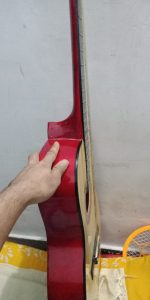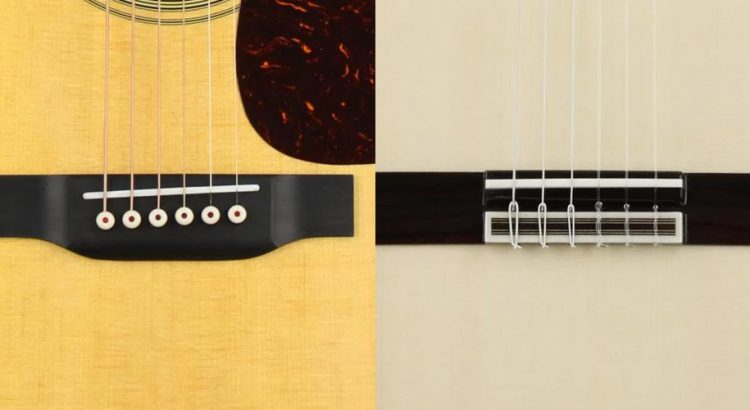

This one is due next. Someone decided to throw on steel strings on a Classical Guitar and get a bigger bang for their buck: foolishness brought on by ignorance!
Every acoustic guitar – Western Flat Top (Steel String), the Resonator, Classical (Spanish), the Archtop – was made keeping a particular music in mind. That is to say each of their constituent elements vary a bit in size, shape and dimension to give it that characteristic sound, which is suited for THEIR kind of music.
The Classical Guitar is meant to play Flamenco, Gypsy Jazz and Western Classical music, though it would be wrong to say that you can play ONLY that kind of music on it. To produce that particular sound, the bracing pattern, the braces themselves, the thickness of the top of the guitar, the neck of the guitar and the strings are vastly different from any other guitar.
The Guitar Top and its Braces
According to Andrew Enns, head luthier at the classical-guitar company, Córdoba Guitars (a respected name in the Classical Guitar world), the bracing and thickness of the top play an important role in the difference between a classical and a steel-string guitar. “Nylon-string tops are thinner, with smaller, more flexible braces, while steel-string guitars have thicker tops with larger, more rigid braces. The principle behind both is the same, to make the guitar strong enough to hold the strings at pitch, yet flexible enough to vibrate when the strings are plucked,” Enns says.
The Bracing Pattern


Again, to facilitate the greatest vibration of the top in response to the lightest touch of the strings, the Classical Guitar – classically – is braced with wood strips in a pattern that has come to be known as fan bracing. In contrast the steel string guitar has a (slightly) thicker top and heavier bracing, called ‘X-bracing’ which assists the working of steel strings.
Also, the lighter nylon strings that go on the Classical Guitar work best with that light bracing and light top. If you place the same strings on a steel-string top guitar, they will sound dead and useless.
The Neck



Under the fretboard/fingerboard, the common steel string guitar has a furrow running almost through the length of it. In this cavity sits the truss rod. The job of the truss rod is to counter the stress that the steel strings exert on the neck and can be worked from the outside to bend the neck in one direction or another.
Contrastively, the Classical Guitar neck has no such feature, for the possibility of it facing any such tension does not exist. New-age luthiers have begun experimenting with carbon fibre strips implanted in the neck, but then these cannot be worked like the truss rod can. They are just there to reinforce the neck and give it strength. Also, even with these implants, the Classical Guitar neck is incapable of taking the strain of steel strings.
The strings

The total tension that classical (nylon) strings exert on the guitar top is never more than 40 – 41 kg. Compare that to the 70-72 kg tension that (the lightest) steel strings exert.
Without the typical bracing pattern, the size of braces to support the top, and a truss rod countering that 72-kg force, any guitar will fold on itself.
And so…
If you do not want your instrument to fold on itself, PLEASE do not make the mistake of putting steel strings on a Classical Guitar!
